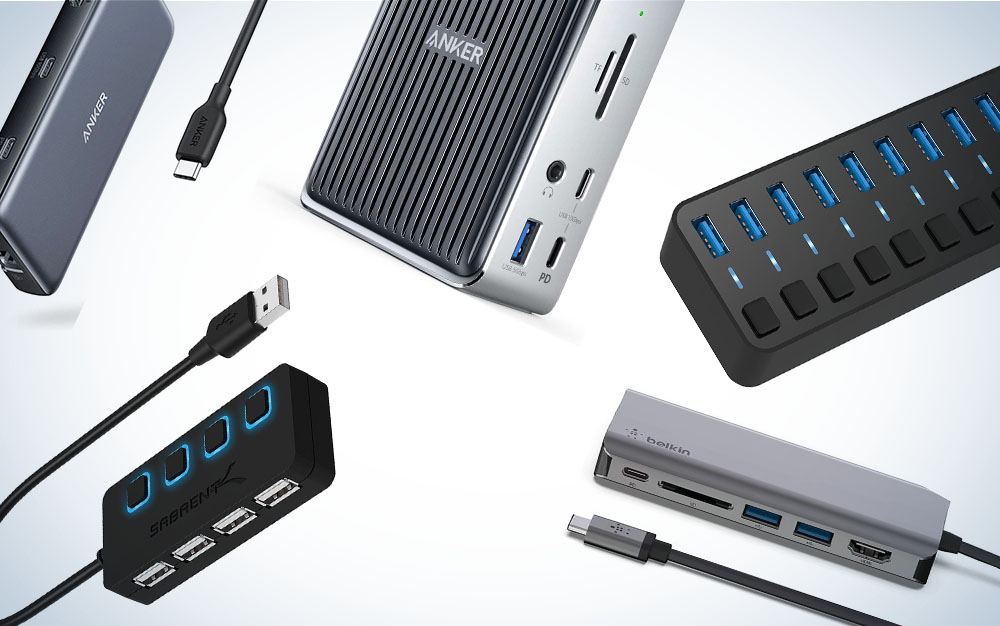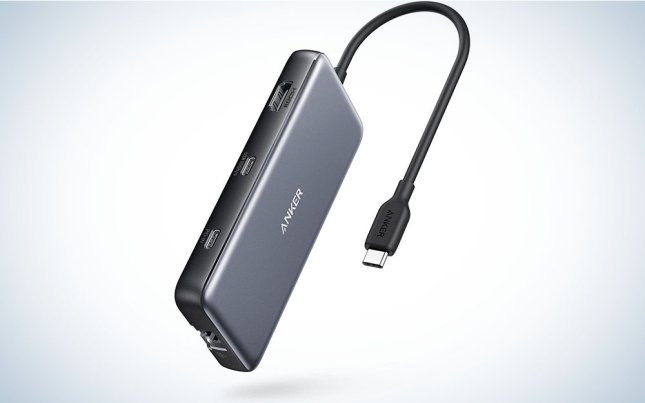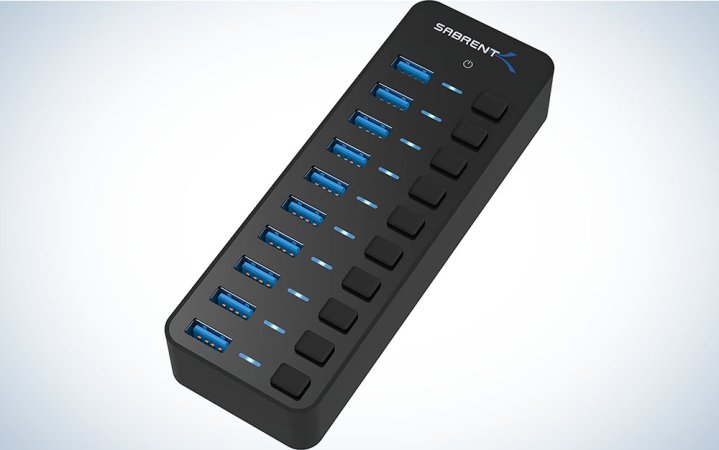We may earn revenue from the products available on this page and participate in affiliate programs. Learn more ›

The best USB hubs reclaim all the ports computers have lost in the pursuit of thinner, smaller, and lighter machines. These handy hubs help connect just about any peripheral including external drives, monitors, card readers, and more.
USB hubs not only give you more USB-C and A ports, but they often include HDMI outputs for running multimedia presentations or using a second monitor. They sometimes include Micro or standard SD card readers, and Ethernet ports for networking your machine. For laptops that also draw power through the USB port, many hubs provide powered pass-through connections, and some even have jacks dedicated to charging devices like phones, tablets, and wireless earbuds.
Thanks to upgraded design philosophies, the best USB hubs not only look nicer on your desk but are also small enough to drop into a bag for easy and convenient travel. Finding the best USB hubs means sifting through a lot of products, so read on to find our favorites.
- Best overall: Anker PowerExpand 8-in-1 USB C Adapter
- Best for business travel: Belkin USB-C Hub MultiPortAdapter Dock
- Best for multimedia: Anker PowerExpand Elite 13-in-1
- Best for desktops: Sabrent 10-port USB Hub
- Best budget: Sabrent 4-Port USB 2.0 Hub
How we selected the best USB hubs
When evaluating the best USB hubs, we consulted external reviews, talked with computer experts, read manufacturer spec sheets, and relied on our own professional experience. We focused on the criteria of speed, number of ports, type of ports, and portability when considering which hubs to include on this list. To a lesser extent, and where warranted, the price was taken into account as well. More than a dozen USB hubs were considered before arriving at our top-five choices.
Things to consider before buying the best USB hub
USB, which stands for Universal Serial Bus, comes in a few flavors, and understanding their differences helps when purchasing a hub.
Catching the BUS
The type of physical connector is denoted by a letter, either A, B, or C. You’re probably very familiar with USB-A ports—they’re the rectangular ones that always seem to be upside down every time you try to plug in a cable. You’ll find the roughly square-shaped USB-B ports found on peripherals like scanners, printers, and audio interfaces. Finally, many modern computers have USB-C ports, which have a flattened, oval shape.
The standards that describe USB’s data transfer speed use numbers. Currently, most computers with higher-performance ports use USB 3.0 (5 gigabits per second), though older USB 2.0 connections (480 megabits per second) are still fairly common. The highest performing hubs include 3.1 Gen 2 ports (10Gbps), or even Thunderbolt, which transfers data at a whopping 40Gbps.
Devices that support USB 3.1 will read data from USB 2.0 outputs. However, the maximum data speed will be determined by the slowest link in the data chain.
So, why does speed matter? If you’re connecting an external keyboard or mouse or transferring text documents or spreadsheets, USB 2.0 works great. But if you create video content or 3D games, or edit large photo files, and your data is stored on a fast external hard drive or SSD, you’ll want to take advantage of USB 3.1’s or Thunderbolt’s higher speeds for the best performance possible. Thunderbolt connections can also drive 4K monitors without any lag.
Connections
It’s a simple idea: USB hubs provide computers with more connections. For instance, plugging a hub into your laptop’s last, open USB-C port creates three or four new places to connect peripherals. Some hubs also act as adapters, allowing you to plug devices with USB-A connectors into a computer with only USB-C inputs (or vice-versa). Finally, many hubs expand the type of connections available to your computer, adding HDMI outputs for video or 4K monitors, card readers for more convenient data transfer, and ethernet ports for network connectivity. Some even offer an extra microphone or headphone jacks for more flexible audio performance.
Monitoring speed
While many hubs include an HDMI output that technically works with 4K monitors, look for hubs that can handle 60Hz refresh rates. They cost more than the hubs that tap out at the more common 30Hz, but the result is smoother movement and animation on the higher resolution screens. If you paid for a fancy 4K monitor, you want to get the best performance from it—don’t let a cheap USB hub stand in the way.
Design
There was a time when USB hubs were bulky and ugly, but thankfully, today’s devices look good on your desk. If you travel, select a lightweight model that stows easily in a briefcase, backpack, or shoulder bag. USB hubs won’t do you any good if they can’t go to where you use your laptop.
Power
Some USB hubs require an extra power cord that plugs into the wall. These models are great for powering electricity-hungry devices, but they’re not very portable. Hubs that draw power directly from the computer into which they’re plugged are much easier to use on the go but won’t always provide enough juice for the greediest gadgets.
The best USB hubs: Reviews & Recommendations
Best USB hub overall: Anker PowerExpand 8-in-1 USB C Adapter
Why it made the cut: The multiple, high-speed USB ports and SD slots make Anker’s PowerExpand 8-in-1 a great hub, but an HDMI output that supports a 60Hz video signal for 4K monitors makes it our favorite.
Specs
- Weight: 4.5 ounces
- Product Dimensions (LWH): 4.76 x 2.17 x 0.6 inches
- Number of USB Ports: 4
Pros
- One USB-C and two USB-A ports supporting 10Gbps USB 3.1 speeds
- HDMI output supports 60Hz refresh rates
- AC-power pass-through charging for laptops
- SD and MicroSD card slots
Cons
- Somewhat pricier than many hubs
- Fewer ports than some hubs
Anker has long excelled in this product category, so finding them at the top of this list makes sense. Their PowerExpand 8-in-1 has enough ports to accommodate everything except a garden hose.
One USB-C and two USB-A jacks deliver 10Gbps speeds using the USB 3.1 standard for lightning-fast file transfers. This makes them ideal for not only basic file management, but also real-time video editing and audio production. The HDMI port connects easily to external monitors, or use it to send your computer’s content to a TV. True 60Hz video support means that 4K monitors will perform great. If you use SD or MicroSD cards, the included slots alleviate the need for an external reader—one less thing to carry around or lose—and a 1Gbps Ethernet port connects to local networks. The 8-in-1 gets bonus points for a pass-through charging port, which allows you to power your laptop by plugging the AC cable into the hub.
As great as it is, Anker’s PowerExpand 8-in-1 doesn’t include as many USB ports as some devices. And if you’re not running a 4K monitor, or looking to network your computer, those features aren’t important. In that case, you might consider less expensive units with more jacks.
Best USB hub for business travel: Belkin USB-C Hub MultiPortAdapter Dock
Why it made the cut: It has everything a business traveler needs for connecting to a remote workstation without a lot of extra features that will never be useful.
Specs
- Weight: 4.6 ounces
- Product Dimensions (LWH): 4.61 x 1.85 x 0.63 inches
- Number of USB ports: 3
Pros
- USB-A and USB-C ports
- Pass-through charging up to 100 W
- Very compact and easy to pack
Cons
- Slightly pricy
- Lackluster HDMI support for high-res monitors
Belkin has a long reputation for products that are solid, if a little pricey. That’s the case with this 6-in-1 hub. It packs a pair of USB-A 3.0 ports alongside a single USB-C 3.0 connector. The HDMI port supports 4K monitors, but only up to 30Hz. It draws all the power it needs directly from the connected computer via its built-in USB-C cable. At 4.6 ounces, it weighs just over a quarter-pound and it’s small enough that you could slip it in a pocket if you don’t have time to cram it into a travel bag. The understated design also works well with the business travel motif with no flashy lights or unnecessary graphics. — Stan Horaczek
Best USB hub for multimedia: Anker PowerExpand Elite 13-in-1
Why it made the cut: Four of the Elite’s 7 USB ports deliver data at 10Gbps or faster, and the hub supports 60Hz refresh rates for the best experience with 4K monitors, making this a monster in creative, multimedia environments.
Specs
- Weight: 1.1 pounds
- Product Dimensions (LWH): 4.96 inches by 3.5 inches by 1.65 inches
- Number of USB Ports: 8
Pros
- Two Thunderbolt 3 ports support 40Gbps transfer rates
- Two USB 3.1 Gen 2 ports support 10Gbps transfer rates
- Supports 60Hz refresh rates for 4K video signals
Cons
- Expensive
- Requires external AC power
- Not very portable
High-end creative environments require fast methods for moving data. Anker’s Elite 7 delivers, with not only two USB 3.1 Gen 2 ports for transfer speeds of 10Gbps, but also two Thunderbolt 3 ports that support 40Gbps transfers. This makes working with video and 3D graphics files in real-time significantly easier. The hub also supports video refresh rates of 60Hz for 4K monitors. Anker rounds out the unit with three USB-A jacks for printers, keyboards, thumb drives, or other peripherals. An ethernet port supports gigabit networking. Anker conveniently placed slots for SD and MicroSD cards on the front of the Elite, as well as charging ports for both USB-A and USB-C devices, and a mini-TRS audio input and output jack.
While the hub is light enough to take on the road, you’ll need AC power to use it. If you’re the kind of person who likes to work in the park or a local coffee shop, this isn’t for you. The Elite 13-in-1 is also the most expensive unit on our list.
Best USB hub for desktops: Sabrent 10-port USB Hub
Why it made the cut: Sabrent’s 10-port USB 3.0 hub provides more than enough spots to plug peripherals and drives, while individual power switches help save energy when your gear’s not in use.
Specs
- Weight: 1.33 pounds
- Product Dimensions (LWH): 5.7 inches by 1.9 inches by .94 inches
- Number of USB Ports: 10
Pros
- All ports are USB 3.0
- Individual on/of switches
- Upward-facing design saves desk space
Cons
- No SD or MicroSD card reader
- No USB-C jacks
If you’re using a desktop computer then you probably already have an ethernet connector and either HDMI or video out for your monitor. You really need more USB jacks for all your peripherals, hard drives, thumb drives, and portable devices. Sabrent’s 10-port hub satisfies that need, and with 5Gbps data speeds from each, the hub can efficiently handle all your files.
The Sabrent’s upward-facing design makes plugging and unplugging USB cables much easier. It also saves space on your desk and makes it hard for cables to accidentally disconnect. The hub’s handy on/off switches—one for each jack—help rein in power consumption by shutting down peripherals that aren’t in use but that you don’t want to unplug.
The Sabrent isn’t really designed with travel in mind—it lacks the extra features like card readers and ethernet jacks, and it requires AC power. However, it’s still compact enough to toss in a suitcase or backpack if you’re traveling between a home and office workspace.
Best budget USB hub: Sabrent 4-Port USB 2.0 Hub
Why it made the cut: For less than $10, you get four extra USB 2.0 ports for peripherals, freeing up your machine’s faster ports for external hard drives and other data-intensive devices.
Specs
- Weight: 2 ounces
- Product Dimensions (LWH): 3.4 inches by 1.4 inches by .61 inches
- Number of USB Ports: 4
Pros
- Extremely cheap
- Compact, portable design
- Individual on/off switches
Cons
- Only delivers USB 2.0 speeds
- Only has USB-A ports, so adapters might be needed for USB C devices
Sometimes you just need a few more USB ports and you don’t want to dig deep into your wallet to get them. Sabrent’s tiny, portable hub fits the bill. Its four ports only clock in at 480Mbps, but that’s perfect for attaching a printer, scanner, thumb drive, or webcam while keeping your machine’s built-in USB 3.0 or Thunderbolt jacks free for high-speed applications.
Individual power switches help keep your office energy efficient, and the compact design slips cleanly into a laptop bag. At less than $10 each, these also make great hubs for the family, and can even find a home on gaming devices.
FAQs
The difference between USB 2.0 and USB 3.0 is their speeds. A USB 2.0 hub transfers data at 480 Megabits per second, while a USB 3.0 hub opens the floodgates for 5 Gigabits per second—or more than 10 times the speed. USB 2.0 hubs are excellent for use with peripherals like scanners or printers, or for transferring smaller data files. If you’re working with video or very large photos, USB 3.0 makes a lot more sense. USB 3.0 hubs are compatible with USB 2.0 devices, but you’ll only get the 480Mbps speeds. Also, keep in mind, most hubs with USB 3.0 cost more.
Powered USB hubs aren’t necessarily better, and your personal requirements will determine which hub is best for your workspace. However, powered USB hubs often use AC power for a reason: they provide a greater number of high-speed data ports, including HDMI for external 4K monitors, and through-ports for laptop charging. These hubs often have not only USB 3.1 Gen 2 jacks (10 Gbps) but also Thunderbolt (40Gbps). That performance requires a lot of energy! The trade-off, of course, is portability. If you can’t plug the hub in, it’s just a paperweight. These are often best suited for people who work at a desk, though if you travel between gigs, many fit easily in a backpack or gear bag.
A USB hub does not reduce speed unless you’re using one that’s slower than the computer USB port it’s plugged into. For instance, if you use a hub with USB 2.0 and plug it into your computer’s Thunderbolt port, the hub will create a pinch-point that slows up data transfer—nothing will move faster than the USB 2.0’s 480Mbps. On the other hand, if you were to plug that same hub into your computer’s USB 2.0 port, you shouldn’t notice a slowdown at all. It’s important to check your computer’s specs to see how fast your internal USB ports are because they’re not always the same. Choose the right port for the right application to get the most efficient speeds from your system.
Final thoughts on selecting the best USB hubs
Given the company’s experience in the field of computer peripherals, we’re not entirely surprised that Anker manufactures some of the best USB hubs on the market. The PowerExpand 8-in-1 delivers high-end performance with fast data speeds, a wide variety of ports, and 60Hz video support for the best 4K monitor experience. It’s portable, competitively priced, and even looks good (for a computer peripheral). That said, if you’re working in a multimedia environment, you can’t go wrong with Anker’s PowerExpand Elite 13-in-1, which adds Thunderbolt performance for high-speed drives or additional monitors, an HDMI output with 60Hz video support, and slots for SD cards. However, it requires AC power to drive everything and costs quite a bit more. Unless it’s something you really need, consider the 8-in-1.







